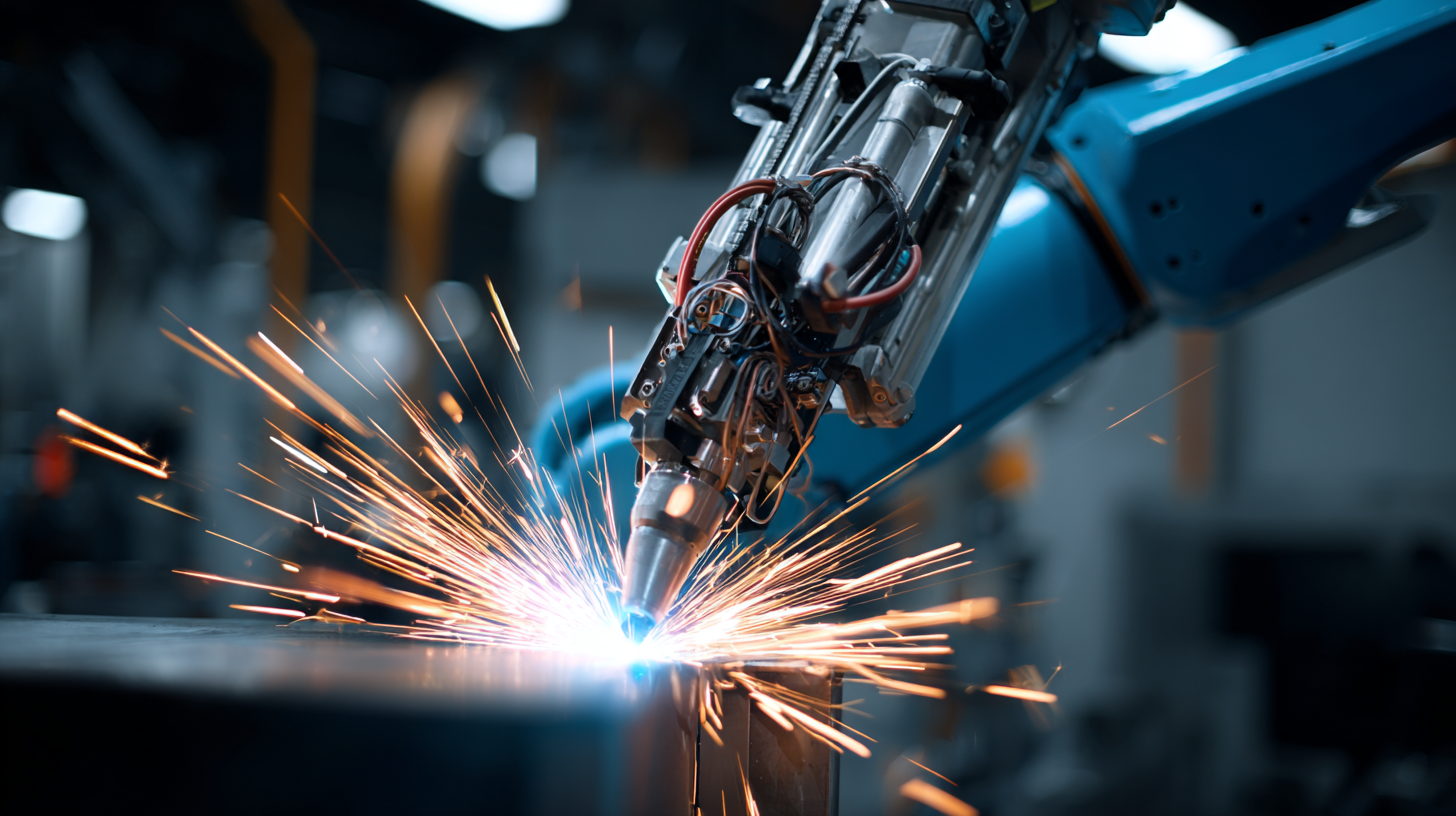Exploring the Future of Robotic Laser Welding in Advanced Manufacturing Techniques
 As the landscape of advanced manufacturing continues to evolve, the integration of cutting-edge technologies plays a pivotal role in enhancing efficiency and precision. One such technology at the forefront is robotic laser welding, a sophisticated process that combines the precision of lasers with the versatility of robotics. This innovative approach not only streamlines production but also enables manufacturers to tackle complex geometries and materials with unprecedented accuracy. In the coming years, the future of robotic laser welding promises to redefine manufacturing capabilities, driving down costs and improving quality through automation. By exploring the various advancements in this field, we can gain insights into how robotic laser welding will shape the industry, addressing current challenges and paving the way for a more efficient and sustainable manufacturing environment.
As the landscape of advanced manufacturing continues to evolve, the integration of cutting-edge technologies plays a pivotal role in enhancing efficiency and precision. One such technology at the forefront is robotic laser welding, a sophisticated process that combines the precision of lasers with the versatility of robotics. This innovative approach not only streamlines production but also enables manufacturers to tackle complex geometries and materials with unprecedented accuracy. In the coming years, the future of robotic laser welding promises to redefine manufacturing capabilities, driving down costs and improving quality through automation. By exploring the various advancements in this field, we can gain insights into how robotic laser welding will shape the industry, addressing current challenges and paving the way for a more efficient and sustainable manufacturing environment.
Future Trends in Robotic Laser Welding for Advanced Manufacturing
The future trends in robotic laser welding are poised to reshape the advanced manufacturing landscape significantly. As industries continue to adopt automation, robotic laser welding technology is emerging as a key player due to its precision and efficiency. Various welding types, including arc, resistance, and solid-state, are being integrated with advanced laser systems. For instance, diode and fiber lasers are gaining traction in applications such as joining and cutting, driven by their adaptability and the ability to produce high-quality welds.

Market insights reveal a burgeoning demand for robotic laser welding solutions across critical sectors like aerospace and automotive. As manufacturers seek to enhance productivity and reduce operational costs, the adoption of these systems is projected to grow at an impressive rate. Anticipations of market sizes expanding significantly by 2032 reflect the competitive dynamics between nations, especially between the U.S. and China, both striving to dominate the robotics space. With Chinese firms benefiting from robust policy support and the established supply chain, while U.S. companies leverage cutting-edge AI algorithms, the landscape for robotic laser welding technology will continue to evolve, setting the stage for remarkable innovation in advanced manufacturing techniques.
Key Advantages of Integrating Robotics in Laser Welding Processes
The integration of robotics in laser welding processes presents numerous advantages that enhance efficiency and precision in advanced manufacturing techniques. One of the primary benefits is the significant increase in speed and productivity. Robotic systems can operate continuously without fatigue, enabling higher throughput rates. This efficiency is particularly valuable in industries that demand high-volume production, where traditional welding methods may struggle to keep pace.
Moreover, robotic laser welding allows for greater precision and consistency in the weld quality. With advanced programming and real-time monitoring capabilities, robotic systems can maintain tight tolerances and repeatability, reducing the risk of defects. This precision is crucial for applications in sectors like aerospace and automotive, where the integrity of welded joints is paramount. Additionally, the automation of welding processes minimizes human error and variability, leading to better overall product quality and reduced costs associated with rework and scrap.
Exploring the Future of Robotic Laser Welding in Advanced Manufacturing Techniques - Key Advantages of Integrating Robotics in Laser Welding Processes
| Advantage | Description | Impact on Production |
|---|---|---|
| Increased Precision | Robotic systems ensure consistent and accurate welds, reducing human error. | Minimizes rework and defects, thus increasing overall quality. |
| Enhanced Speed | Automation allows for faster welding processes compared to manual operation. | Increases throughput and reduces lead time in production. |
| Improved Safety | Minimizes human exposure to high-energy welding processes. | Reduces workplace accidents and enhances worker safety. |
| Versatility | Robotics can be programmed for different applications and materials. | Enhances flexibility in production processes, accommodating varying demands. |
| Cost Efficiency | Reduces labor costs and increases energy efficiency. | Lowers operational costs while maintaining high production standards. |
Technological Innovations Enhancing Robotic Laser Welding Efficiency
Robotic laser welding is rapidly transforming the landscape of advanced manufacturing through a series of groundbreaking technological innovations. One of the key advancements is the integration of artificial intelligence and machine learning algorithms that enable real-time process monitoring and adaptive control. These technologies ensure optimal laser parameters are maintained, improving weld quality and reducing defects. Furthermore, predictive analytics are being utilized to anticipate equipment failures, minimizing downtime and enhancing overall productivity.
Another significant innovation lies in the development of advanced laser systems, including fiber lasers that offer higher beam quality and efficiency. These lasers provide greater flexibility in welding different materials and thicknesses, making robotic welding systems more versatile. Coupled with enhanced optics and beam shaping technologies, manufacturers can achieve precise welds even in complex geometries. As these innovations continue to evolve, they not only enhance the efficiency of robotic laser welding but also pave the way for new possibilities in customized manufacturing and rapid prototyping.

Challenges and Solutions in Adopting Robotic Laser Welding
As industries increasingly embrace advanced manufacturing techniques, robotic laser welding has emerged as a powerful solution for enhancing productivity and precision. However, the adoption of this technology is not without challenges. One major hurdle is the initial investment cost, which can deter small and medium-sized enterprises from implementing robotic laser welding systems. The complexity of integrating these advanced systems into existing production lines also poses significant technical challenges, requiring skilled personnel and comprehensive training programs.
Moreover, the variability in material properties and thickness can complicate the welding process, leading to inconsistent results if not managed properly. To address these issues, manufacturers can invest in simulation software to rigorously test and optimize the welding processes before actual implementation. Developing partnerships with technology providers can also facilitate knowledge transfer and skill development for workers. By focusing on these solutions, companies can not only mitigate the challenges associated with robotic laser welding but also unlock its full potential to revolutionize their manufacturing capabilities.
Challenges and Solutions in Adopting Robotic Laser Welding
Applications of Robotic Laser Welding Across Various Industries
Robotic laser welding is revolutionizing the way industries approach manufacturing. One of the most prominent applications is in the automotive sector, where precision and speed are critical. Manufacturers are increasingly adopting robotic laser welding to create strong, lightweight joints in body structures, contributing to vehicles' overall efficiency and durability. This technology allows for high-speed processing and minimal thermal distortion, which is essential in maintaining the integrity of complex automotive components.
In the aerospace industry, the demand for lightweight materials is pushing the boundaries of traditional welding methods. Robotic laser welding provides a solution by allowing for seamless fusion of advanced materials such as titanium and aluminum alloys. This capability enhances the structural performance of aircraft while reducing overall weight. Moreover, with the integration of sensors and artificial intelligence, robotic systems can adapt to varying material conditions, ensuring consistent quality and reducing waste. As robotic laser welding evolves, its applications are likely to expand further into industries like electronics and medical devices, where precision and cleanliness are paramount.
Related Posts
-

Unlocking the Future of Automation with Revolutionary Robot Software
-

Transforming Industry with Intelligent Robots at the 138th Canton Fair in 2025
-

Exploring the Future of Robot Servo Technology at the 2025 China Import and Export Fair
-

Unlocking the Future of Automation with Digital Robotic Process Techniques
-

Exploring the Future of Robotic Vision: Innovations That Transform Industries
-

Unlocking the Future of Automation with Advanced Robot Vision Systems






